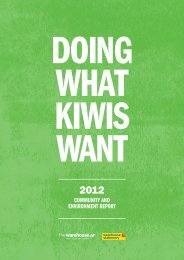ar11-lr-final
You also want an ePaper? Increase the reach of your titles
YUMPU automatically turns print PDFs into web optimized ePapers that Google loves.
Notes to and forming part of the Financial Statements – continued<br />
For the 52 WEEK period ended 31 July 2011<br />
Notes to and forming part of the Financial Statements – continued<br />
For the 52 WEEK period ended 31 July 2011<br />
1. Summary Of Accounting Policies (CONTINUED) (ii) Fair value hedge<br />
1. Summary Of Accounting Policies (CONTINUED)<br />
Interest free loans are provided to plan participants to finance<br />
Changes in the fair value of derivatives that are designated<br />
(t) Intercompany advances<br />
the share purchases. The fair value of the interest free<br />
and qualify as fair value hedges are recorded in the income<br />
Except for a loan of $100.000 million (refer note 39 (f))<br />
component of the loan is included in determining the discount of<br />
statement, together with any changes in the fair value of the<br />
intercompany advances between the parent company and its<br />
shares provided to participants and forms part of the employee<br />
hedged asset or liability that are attributed to the hedged<br />
subsidiaries are non interest bearing and repayable on demand.<br />
benefit expense. The fair value interest free component of the<br />
risk. The Group only applies fair value hedge accounting for<br />
Management’s expectation is that these advances will not be<br />
loan is measured at grant date, using a bank five year swap<br />
hedging fixed interest on borrowings. The gain or loss relating<br />
repaid within the next twelve months and have classified the<br />
rate. When the discount on the loan unwinds an amount is<br />
to the effective portion of interest rate swaps hedging fixed<br />
advances as non-current assets.<br />
recognised as finance income.<br />
rate borrowings and changes in the fair value of the fixed rate<br />
borrowings attributable to interest rate risk are recognised in the<br />
(u) Provisions<br />
(p) Derivatives<br />
The Group is party to the following financial derivatives:<br />
• Forward foreign exchange rate contracts<br />
income statement within net interest expense.<br />
If the hedge no longer meets the criteria for hedge accounting,<br />
the adjustment to the carrying amount of the hedged item, for<br />
Provisions are recognised when:<br />
• the Group has a present legal or constructive obligation as a<br />
result of past events;<br />
which the effective interest method is used, is amortised over<br />
• Interest rate swaps<br />
• it is more likely than not that an outflow of resources will be<br />
the period to maturity.<br />
required to settle the obligation;<br />
• Electricity hedge contracts<br />
(iii) Derivatives that do not qualify for hedge accounting<br />
• the amount has been reliably estimated.<br />
Derivatives are initially recognised at fair value on the date Certain derivative instruments do not qualify for hedge<br />
a derivative contract is entered into and are subsequently<br />
remeasured to their fair value. The method of recognising the<br />
resulting gain or loss depends on whether the derivative is<br />
accounting. Changes in the fair value of any derivative<br />
instrument that does not qualify for hedge accounting are<br />
recognised immediately in the income statement.<br />
Provisions are not recognised for future operating losses.<br />
Where there are a number of similar obligations, the likelihood<br />
that an outflow will be required in settlement is determined by<br />
designated as a hedging instrument, and if so, the nature of the<br />
considering the class of obligations as a whole. A provision is<br />
(q) Fair value estimation<br />
item being hedged.<br />
recognised even if the likelihood of an outflow with respect to<br />
The fair value of financial assets and financial liabilities must<br />
any one item included in the same class of obligations may be<br />
For the purposes of hedge accounting, hedges are classified as: be estimated for recognition and measurement or for disclosure<br />
small.<br />
purposes. The fair value of financial instruments traded in active<br />
• Cash flow hedges when they hedge the exposure to variability<br />
markets (such as publicly traded derivatives) is based on quoted<br />
(v) Segment reporting<br />
in cash flows that is attributable either to a particular risk<br />
market prices at the balance sheet date. The quoted market<br />
An operating segment is a Group of assets and operations<br />
associated with a recognised asset or liability or to a highly<br />
price used for financial assets held by the Group is the current<br />
engaged in providing products or services that are subject to<br />
probable forecast transaction; or<br />
bid price; the appropriate quoted market price for financial<br />
risks and returns that are different to those of other operating<br />
• Fair value hedges when they hedge the exposure to changes liabilities is the current ask price.<br />
segments. These segments form the basis of internal reporting<br />
in fair value of a recognised asset or liability.<br />
used by Management and the Board of Directors to monitor and<br />
The fair value of forward exchange contracts is determined using<br />
assess performance and assist with strategy decisions.<br />
The Group documents at the inception of the transaction the forward exchange market rates at the balance date.<br />
relationship between hedging instruments and hedged items,<br />
The Group currently operates solely within one geographical<br />
The fair value of interest rate swaps is calculated as the present<br />
as well as its risk management objective and strategy for<br />
segment (New Zealand), and accordingly no geographical<br />
value of the estimated future cash flows based on the applicable<br />
undertaking various hedge transactions.<br />
segment analysis is provided.<br />
market interest yield rates at balance date.<br />
The Group also documents its assessment, both at hedge<br />
(w) Contributed equity<br />
The fair value of electricity ‘contracts for difference’ is calculated<br />
inception and on an ongoing basis, of whether the derivatives<br />
Ordinary shares are classified as equity. Incremental costs,<br />
as the present value of the estimated future cash flows based<br />
that are used in hedging transactions have been and will<br />
directly attributable to the issue of new shares, are shown in<br />
on available market electricity pricing at balance date.<br />
continue to be highly effective in offsetting changes in fair<br />
equity as a deduction from the proceeds of the share issue.<br />
values or cash flows of hedged items.<br />
The nominal value less estimated credit adjustments of trade<br />
Where the Group purchases its own equity share capital<br />
receivables and payables are assumed to approximate their fair<br />
(i) Cash flow hedge<br />
(treasury shares), the consideration paid, including any<br />
values.<br />
The effective portion of changes in the fair value of derivatives<br />
directly attributable incremental costs is deducted from equity<br />
that are designated and qualify as cash flow hedges is<br />
recognised in equity in the cash flow hedge reserve. The gain or<br />
loss relating to the ineffective portion is recognised immediately<br />
in the income statement.<br />
Amounts accumulated in equity are recycled in the income<br />
statement in the periods when the hedged item will affect profit<br />
or loss (for instance when the forecast interest payment that is<br />
hedged takes place). However, when the forecast transaction<br />
(r) Trade and other payables<br />
These amounts represent liabilities for goods and services<br />
provided to the Group prior to the end of financial year which are<br />
unpaid. The amounts are normally unsecured and are usually<br />
settled within 60 days of recognition.<br />
(s) Borrowings<br />
Borrowings are initially recognised at fair value, net of<br />
transaction costs incurred. Borrowings are subsequently<br />
attributable to the shareholders until the shares are cancelled<br />
or reissued. Where such shares are reissued, any consideration<br />
received, net of any directly attributable incremental transaction<br />
costs, is included in equity attributable to shareholders.<br />
(x) Dividends<br />
Provision is made for the amount of any dividend declared, being<br />
appropriately authorised by the Board of the Group, on or before<br />
the end of the financial year but not distributed at balance date.<br />
that is hedged results in the recognition of a non-financial measured at amortised cost. Any difference between the<br />
(y) Foreign currencies<br />
asset (for example, inventory), the gains and losses previously proceeds (net of transaction costs) and the redemption amount<br />
Transactions in foreign currencies are converted to New Zealand<br />
deferred in equity are transferred from equity and included in the is recognised in the income statement over the period of the<br />
dollars at the exchange rate ruling at the date of the transaction.<br />
measurement of the initial cost or carrying amount of the asset borrowings using the effective interest method.<br />
At balance date monetary assets and liabilities denominated<br />
or liability.<br />
Borrowings are classified as current liabilities unless the Group<br />
in foreign currencies are retranslated to New Zealand dollars at<br />
When a hedging instrument expires or is sold or terminated,<br />
or when a hedge no longer meets the criteria for hedge<br />
accounting, any cumulative gain or loss existing in equity at<br />
that time remains in equity and is recognised when the forecast<br />
transaction is ultimately recognised in the income statement.<br />
When a forecast transaction is no longer expected to occur,<br />
the cumulative gain or loss that was reported in equity is<br />
immediately transferred to the income statement.<br />
has an unconditional right to defer settlement of the liability for<br />
at least 12 months after the balance date.<br />
Borrowing costs incurred for the construction of any qualifying<br />
asset are capitalised during the period of time that is required to<br />
complete and prepare the asset for its intended use or sale. The<br />
capitalisation rate used to determine the amount of borrowing<br />
costs to be capitalised is based on a weighted average of the<br />
interest expense incurred by the Group. Other borrowing costs<br />
are recognised as an expense when incurred.<br />
the closing exchange rate, and exchange variations arising from<br />
these translations are recognised in the income statement.<br />
FINANCIAL STATEMENTS 38<br />
(z) Operating profit<br />
Operating profit represents earnings before taxation and<br />
interest adjusted for equity earnings from the Group’s associate<br />
company and any unusual items. Unusual items includes profit<br />
and losses from the disposal of properties, the release of<br />
surplus warranty provisions and unrealised gains or losses from<br />
changes in the fair value of financial instruments.<br />
(aa) Changes to accounting policies that have been adopted<br />
for new accounting standards and new interpretations in the<br />
preparation and presentation of the financial statements:<br />
There have been no significant changes in accounting policies<br />
during the year, however certain comparatives have been<br />
restated to conform with the current years presentation.<br />
(ab) New and proposed accounting standards, amendments<br />
and interpretations to existing standards that are relevant<br />
to the Group, but not yet effective, and have not been early<br />
adopted by the Group, are:<br />
NZIFRS 9 Financial Instruments effective for periods beginning<br />
on or after 1 January 2013. This standard is part of the<br />
International Accounting Standards Board’s (IASB) project to<br />
replace IAS 39 Financial Instruments. The new standard requires<br />
two primary measurement categories for financial assets,<br />
amortised cost and fair value, with classification depending<br />
upon the entity’s business model, and the contractual cash flow<br />
characteristics of the financial asset. At its July 2011 meeting<br />
the IASB tentatively agreed to defer the mandatory effective<br />
date of IFRS 9 to periods beginning on or after 1 January 2015<br />
with early application still permitted. The deferral of IFRS 9<br />
will be proposed in an exposure draft, which has not yet been<br />
released. Management is currently in the process of evaluating<br />
the potential effect of adoption of NZ IFRS 9, but the impact of<br />
the standard is not expected to be material to the Group.<br />
In August 2010, the IASB and U.S. Financial Accounting<br />
Standards Board (FASB) published joint exposure drafts (ED),<br />
with the IASB issuing ED 2010/9 Leases.<br />
The ED proposes new models for lessee and lessor<br />
accounting, which significantly change the current lease<br />
accounting requirements. Under the proposed ‘right-of-use’<br />
model, all leases would effectively be ‘on balance sheet’.<br />
The calculation of recognised amounts would be based<br />
on an ‘expected outcome’ approach, requiring both up-front<br />
and continuous estimates of lease term, contingent rentals<br />
and residual guarantees.<br />
The IASB and FASB noted in a press release in July 2011, that<br />
the decisions taken to date in response to feedback received<br />
following the release of the ED were sufficiently different<br />
from those published in the first ED to warrant re-exposure of<br />
the revised leasing proposal . The IASB and FASB intend to<br />
complete their deliberations during the third quarter of 2011<br />
with a view to publishing a revised ED shortly there after.<br />
Management will re-evaluate the potential effects of the<br />
revised exposure draft when it is released, however it is<br />
expected that any new standard on lease accounting will<br />
significantly impact both the Group’s income statement<br />
and balance sheet. A new accounting standard is not<br />
expected to be released until at least 2012, with an<br />
effective date not expected to be earlier than 2015.<br />
FINANCIAL STATEMENTS 39
















